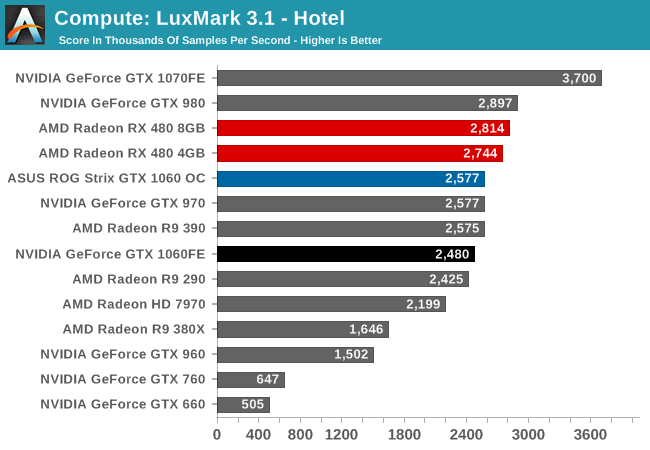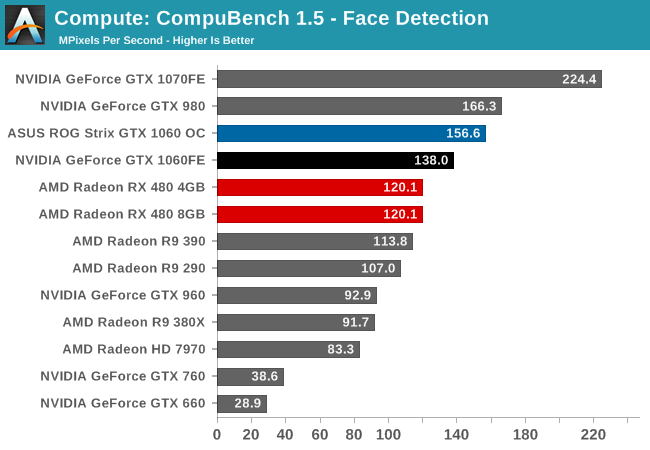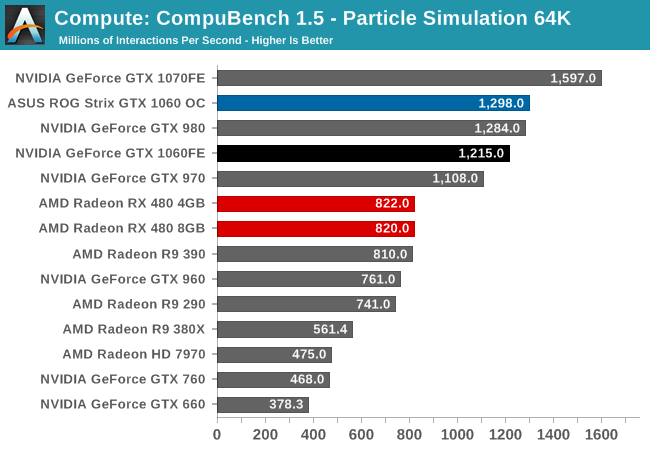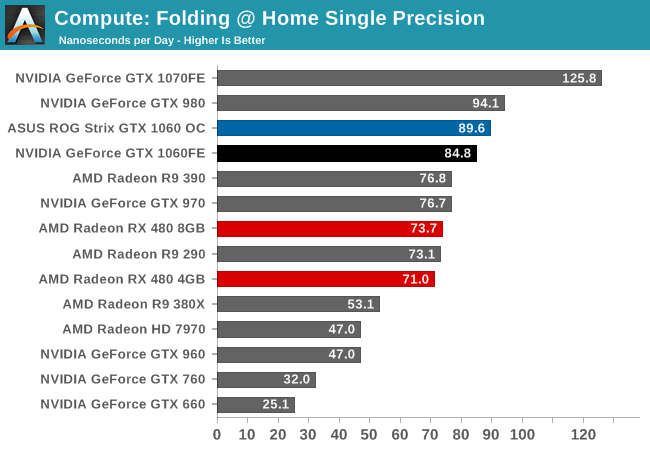The GeForce GTX 1060 Founders Edition & ASUS Strix GTX 1060 Review
by Ryan Smith on August 5, 2016 2:00 PM ESTCompute
Shifting gears, let’s take a look at compute performance on GTX 1060.
As we already had the chance to categorize the Pascal architecture’s compute performance in our GTX 1080 review, there shouldn’t be any surprises here. But it will be interesting to see whether the GTX 1060’s higher ratio of memory bandwidth per FLOP materially impacts overall compute performance.
Starting us off for our look at compute is LuxMark3.1, the latest version of the official benchmark of LuxRender. LuxRender’s GPU-accelerated rendering mode is an OpenCL based ray tracer that forms a part of the larger LuxRender suite. Ray tracing has become a stronghold for GPUs in recent years as ray tracing maps well to GPU pipelines, allowing artists to render scenes much more quickly than with CPUs alone.

While GTX 1060 could hang with GTX 980 in gaming benchmarks, we don’t start off the same way with compute benchmarks, with the last-generation flagship holding about 17% ahead. Unfortunately for NVIDIA, this is about where GTX 1060 needed to be to best RX 480; instead it ends up trailing the AMD competition. Otherwise the performance gain versus the GTX 960 stands at 65%.
For our second set of compute benchmarks we have CompuBench 1.5, the successor to CLBenchmark. CompuBench offers a wide array of different practical compute workloads, and we’ve decided to focus on face detection, optical flow modeling, and particle simulations.



Like with GTX 1080, relative performance is all over the place. GTX 1060 wins with face detection, loses at optical flow, and wins again at particle simulation. Even the gains versus GTX 960 are a bit more uneven, though at the end of the day GTX 1060 ends up being significantly faster than its predecessor with all 3 sub-benchmarks.
Moving on, our 3rd compute benchmark is the next generation release of FAHBench, the official Folding @ Home benchmark. Folding @ Home is the popular Stanford-backed research and distributed computing initiative that has work distributed to millions of volunteer computers over the internet, each of which is responsible for a tiny slice of a protein folding simulation. FAHBench can test both single precision and double precision floating point performance, with single precision being the most useful metric for most consumer cards due to their low double precision performance. Each precision has two modes, explicit and implicit, the difference being whether water atoms are included in the simulation, which adds quite a bit of work and overhead. This is another OpenCL test, utilizing the OpenCL path for FAHCore 21.


Finally, in Folding@Home, we see the usual split between single precision and double precision performance. GTX 1060 is solidly in the lead when using FP32, but NVIDIA’s poor FP64 rate means that if double precision is needed, RX 480 will pull ahead.










189 Comments
View All Comments
DominionSeraph - Friday, August 5, 2016 - link
Aw, look at the fanboy complain that it isn't "fair" because they didn't only present AMD's strengths and Nvidia's weaknesses, but instead used tests representative of the gaming landscape.beck2050 - Monday, August 8, 2016 - link
Nvidia has driver teams as well. Plus 22% with the latest Dx12 Hitman. 1060 will compete very well. Cooler faster less energy, and priced accordingly.eddman - Saturday, August 6, 2016 - link
So much misinformation still going around. Gameworks effects are either CPU only, which have ZERO effect on the GPU, no matter the brand, like waveworks in just casue 3, or are GPU based, which can be DISABLED, like witcher 3's hairworks or HBAO+, or RotTR's HBAO+ and VXAO.Ryan Smith - Friday, August 5, 2016 - link
The benchmark suite was finalized back in May, when the DX12 version of Tomb Raider was rubbish. I talk a bit more about this in another comment, but basically we only periodically update the benchmark suite due to the amount of work involved and the need to maintain a consistent dataset for Bench. The plan is to do another update in September.Colin1497 - Saturday, August 6, 2016 - link
I understood that situation. Last thing you needed was to change the games when you were running behind. Just commenting on the change in the landscape over 2 months. Doom and Vulcan is obviously another thing. Looking forward to what you do next.Simplex - Sunday, August 7, 2016 - link
It's "Vulkan", not "Vulcan".MarkieGcolor - Friday, August 5, 2016 - link
Please include 4k, and crossfire/sli setups in your benchmarks. Otherwise I do not care about this late review.xenol - Friday, August 5, 2016 - link
4K seems kind of pointless, we all know it's going to be sub 40FPS which few people are going to recommend this card for 4K gaming.Also what's the point of SLI on a card that doesn't support it?
AnnonymousCoward - Friday, August 5, 2016 - link
If 4K is pointless then so are most of the 2560 tests which use ultra settings and produce <60fps.4K with medium settings, no AA would be much more interesting to me.
MarkieGcolor - Saturday, August 6, 2016 - link
True. I'm just saying it would be interesting.I understand that if you want 1060 sli you should just buy 1080, but I feel Nvidia disabled sli to keep the second hand market at bay and sell more new expensive cards.